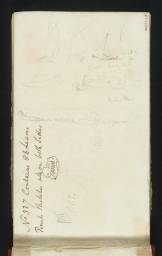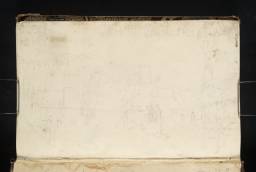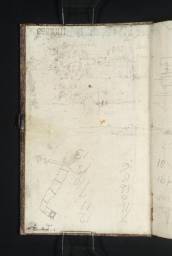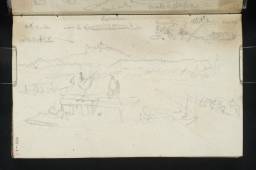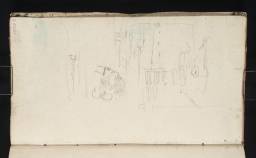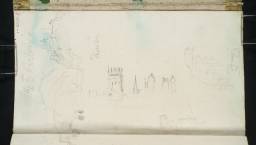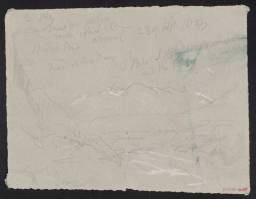Tour of Southern Germany, Austria and Venice 1833
From the entry
In the summer and early autumn of 1833, Turner toured Europe, travelling through Belgium into Germany, up the River Rhine and then eastward to Munich and Salzburg. He approached Vienna down the Danube, and returned to Salzburg before crossing the Alps towards Venice. He was visiting the city on the second of three known occasions (see also under 1819 and 1840 in the present catalogue), before taking a more direct route home through the mountains and back down the Rhine into Holland. In the course of the journey he used seven sketchbooks and some small sheets of grey paper. Most of the route and account of the journey here and in the entries for the individual sketchbooks is based closely on Cecilia Powell’s work establishing the tour and disentangling the books from those used on other European expeditions in the 1830s and 1840s, as set out in the ‘Down the Danube to Vienna, 1833’ chapter of her 1995 Tate Gallery exhibition catalogue Turner in Germany. She confirmed and summarised the outline of ...
Brussels up to Mannheim – Rhine Sketchbook 1833
D29595–D29771, D41099, D41200–D41201
Turner Bequest CCXCVI 1–91a
D29595–D29771, D41099, D41200–D41201
Turner Bequest CCXCVI 1–91a
Heidelberg up to Salzburg Sketchbook 1833
D29814–D29987, D29989–D29998, D30000–D30001, D41209–D41210
Turner Bequest CCXCVIII 1–98a
D29814–D29987, D29989–D29998, D30000–D30001, D41209–D41210
Turner Bequest CCXCVIII 1–98a
Salzburg and Danube Sketchbook 1833
D30130–D30266, D30268–D30295, D41223–D41224
Turner Bequest CCC 1–84a
D30130–D30266, D30268–D30295, D41223–D41224
Turner Bequest CCC 1–84a
Vienna up to Venice Sketchbook 1833
D31416–D31426, D31428–D31466, D31468–D31559, D31561–D31567, D31569–D31570, D31572–D31575, D31577–D31581, D31583–D31586, D31588–D31592, D31594–D31597, D41262–D41263, D41500
Turner Bequest CCCXI 1–94a
D31416–D31426, D31428–D31466, D31468–D31559, D31561–D31567, D31569–D31570, D31572–D31575, D31577–D31581, D31583–D31586, D31588–D31592, D31594–D31597, D41262–D41263, D41500
Turner Bequest CCCXI 1–94a
Venice Sketchbook 1833
D31929–D31936, D31938–D32053, D32055–D32097, D32099–D32116, D41113–D41114
Turner Bequest CCCXIV 1–100a
D31929–D31936, D31938–D32053, D32055–D32097, D32099–D32116, D41113–D41114
Turner Bequest CCCXIV 1–100a
Venice up to Trento Sketchbook 1833
D31598–D31705, D31707, D31709–D31712, D31714–D31732, D31734–D31790, D41110–D41112
Turner Bequest CCCXII 1–100
D31598–D31705, D31707, D31709–D31712, D31714–D31732, D31734–D31790, D41110–D41112
Turner Bequest CCCXII 1–100
Separate sheets (Zirl and the Alps near Innsbruck, and Augsburg)
D33696–D33697, D33796, D33811, D33832, D33840–D33857, D33859–D33866, D40329
Turner Bequest CCCXLI 18, 18v, 115, 129, 147, 155–170v
D33696–D33697, D33796, D33811, D33832, D33840–D33857, D33859–D33866, D40329
Turner Bequest CCCXLI 18, 18v, 115, 129, 147, 155–170v
References
In the summer and early autumn of 1833, Turner toured Europe, travelling through Belgium into Germany, up the River Rhine and then eastward to Munich and Salzburg. He approached Vienna down the Danube, and returned to Salzburg before crossing the Alps towards Venice.1 He was visiting the city on the second of three known occasions (see also under 1819 and 1840 in the present catalogue), before taking a more direct route home through the mountains and back down the Rhine into Holland.
In the course of the journey he used seven sketchbooks and some small sheets of grey paper. Most of the route and account of the journey here and in the entries for the individual sketchbooks is based closely on Cecilia Powell’s work establishing the tour and disentangling the books from those used on other European expeditions in the 1830s and 1840s, as set out in the ‘Down the Danube to Vienna, 1833’ chapter of her 1995 Tate Gallery exhibition catalogue Turner in Germany.2 She confirmed and summarised the outline of the present tour in her chapter ‘Approaches to Venice’, complementing Ian Warrell’s comprehensive coverage of Venice itself in his 2003 Tate Britain catalogue Turner and Venice.3 The last part of the route as set out here, between Augsburg and Rotterdam, is a new addition to the established itinerary.
The entries here have been divided between Alice Rylance–Watson, dealing with the four books along the meandering route to Venice (Brussels up to Mannheim – Rhine, Heidelberg up to Salzburg, Salzburg and Danube, and Vienna up to Venice: Turner Bequest CCXCVI, CCXCVIII, CCC, CCCXI), and the present author, who has covered the principal Venice sketchbook (Venice: Turner Bequest CCCXIV) and the return journey as far as Bavaria (Venice up to Trento: CCCXII). He has also added the Rotterdam and Rhine sketchbook (CCCXXII), building on initial research on its Dutch subjects by Quirine van der Meer Mohr, the co–signatory of its Introduction and many individual entries.
Previous interpretations of the itinerary and dating:
Before addressing the journey as set out here, consideration is given as to how its scope came to be established. Developing Finberg’s fundamental 1909 Inventory work on the individual sketchbooks, where their dating at various points and ranges between 1837 and 1841 had been ‘approximate’ and ‘provisional’,4 his 1930 book In Venice with Turner attempted to set out an overall itinerary for a ‘second visit’ to Venice,5 which he then placed at 1835 as ‘the most probable date’.6 This supposed route encompassed ‘Berlin, Dresden and Prague, (sketch–books, cccvii, cccvi, and ccci) to Vienna, and from Vienna to Salzburg, Innsbruck, Botzen (Bolzano), Verona and Venice (ccxcix and cccxi); and the return journey through Bassano and Levico, Innsbruck, and the Rhine to Dover (cccxii and cccix)’.7
The first three sketchbooks (all Tate, and now known respectively as Copenhagen to Dresden, Dresden and Saxon Switzerland, and Dresden, Teplitz and Prague) are among six established by Powell as having been used on an actual 1835 tour which took in neither Vienna nor Venice;8 see Rylance–Watson’s ‘Northern Germany, the Elbe and Prague’ section in the present catalogue. Trieste, Graz and Danube (Tate; Turner Bequest CCXCIX) belongs to 1840. Finberg’s proposed route from Vienna to Venice, and from Venice to Innsbruck as embodied in the Vienna up to Venice and Vienna up to Trento books, is as followed here for 1833, but the Dover, Rhine and Innsbruck sketchbook9 (Tate; Turner Bequest CCCIX) has since been dated to 1843.10 Finberg also linked the 1833 Venice sketchbook to his ‘second visit’ theory;11 in his subsequent biography of Turner (first published in 1939), he confidently stated that the artist had ‘certainly’ been to Venice in 1835, following the route proposed in 1930.12
A cornerstone of Finberg’s argument was the 1836 Royal Academy showing of Turner’s oil painting Juliet and her Nurse (private collection;13 engraved in 1842 as ‘St Mark’s Place, Venice’: Tate impression T05188), a view east to the campanile of San Marco from high above St Mark’s Square, with fireworks in the distance. He linked the composition to nocturnal colour studies on brown paper such as Tate D32229 (Turner Bequest CCCXVIII 10).14 As Warrell has noted, while such a supposition had ‘the advantage of these compositional elements’, the dating of the numerous studies on brown paper to Turner’s 1833 visit has been ‘crucially undermined’ by Powell’s technical link with a German subject unique to 1840, ‘evidently made on the same sheets’.15 This issue is considered in detail in the present author’s Introduction to the 1840 tour; the many watercolour studies previously linked to 1833/35 are now almost all thought to belong to 1840, and are addressed as such in this catalogue. The exceptions are six studies on grey paper (Tate D32205–D32210; Turner Bequest CCCXVII 20–25), where there is scope for speculation,16 although for practical purposes they too have been grouped with the 1840 material. A few studies on such paper, firmly linked to other stages of the 1833 route, are noted below.
Considering Turner’s three stays in Venice, in 1971 art historian Hardy George noted the problems in considering whether all the European sketchbooks Finberg had listed in relation to a second visit could embody a single coherent route.17 He made a key discovery, through exhaustive examination of the 1830s editions of the weekly Gazzetta Privilegiata di Venezia: ‘On the ninth of September (1833) Turner (“gent. Inglese”) is listed as having arrived from Vienna, but no departure date could be found’ through to the end of the year.18 However, George observed that ‘he must have stayed about ten days, for an inscription in the “from Venice up to Trento” sketchbook informs us that Turner was in “Botzen” on “22 Sepr.”’19
George concluded that the Vienna up to Venice, Venice and Venice up to Trento books belonged to the same tour, the first on account of its subject matter, consistent with the note in the Gazzetta,20 and the other two because of their physical similarities.21 He also discussed the presence or absence of scaffolding on the spire of the campanile of San Marco (St Mark’s) as a key means of differentiating drawings from the three tours, 1833 being the only time when building work was not in progress, as set out in the Introduction to the Venice book.22 This had been observed in unpublished notes by the Turner scholar and curator C.F. Bell (1871–1966), in proposing an 1832 visit in advance of Turner’s first exhibited paintings of Venice the following year (see below).23 George felt ‘Finberg’s grouping of the Venetian sketchbooks around a tour in the mid–1830’s and 1840 seems correct and in general agrees with the arrival and departure information found in the Gazzetta privilegiata di Venezia – if one simply changes the 1835 date to 1833’, but found Bell’s ‘attempt to establish two tours in the 1830’s (ca. 1832 and 1835) ... unconvincing.’24
Having established Turner’s presence in Venice in September 1833, in 1984 George returned to the issue of the wider itinerary in an extended account, in which (as did Finberg) he omitted the initial Brussels up to Mannheim – Rhine leg and included all the same sketchbooks as his predecessor, three of which have since been dated to 1835, and one to 1840, as noted above.25 He also incorporated the Heidelberg up to Salzburg and Salzburg and Danube books,26 which do belong to 1833. The insuperable difficulties in reconciling these different routes understandably led him to ‘long for the clear connections and ordered sketches which made it possible to put the 1819 sketchbooks [including Venice, and Italy more extensively] in order’.27 This was only realised through a coherent overview of Turner’s work in Germany, particularly in 1833, 1835, 1839, 1840 and 1844, resulting from Powell’s research.28
The circumstances of the 1833 tour:
As set out elsewhere on the present catalogue, Turner had first visited Venice for just a few days in 1819, on his first Italian tour. During his extended stay in the country in 1828–9 he was based in Rome, and the nearest he came to Venice was on his return route by way of Bologna and Milan. He had since toured northern France later in 1829, the English Midlands in 1830, Scotland in 1831, and France again in 1832. However, in the spring of 1833 the six paintings he exhibited at the Royal Academy included two Venetian subjects: Bridge of Sighs, Ducal Palace and Custom–House, Venice: Canaletti painting (Tate N00370);29 and Ducal Palace, Venice (currently untraced; engraved 1854 as ‘Venice. The Piazzetta’: Tate impression T06299).30
These were the first oils of the city Turner had shown, nearly fourteen years after his first visit, based on pencil sketches from that occasion as recapped in the Introduction to the Venice sketchbook. They were not entirely out of the blue, since Lindsay Stainton and Ian Warrell have shown that there had been a growing fashion for Venetian subjects by British artists (not least the late Richard Parkes Bonington; see Tate N00374 and N05789) from the mid–1820s into the 1830s.31 Turner was no doubt mindful of wider creative and commercial possibilities, both in terms of Venice and other less familiar European subjects. H.A.J. Munro of Novar, his young Scottish patron and friend,32 had acquired one of the other 1833 paintings,33 and apparently now provided the opportunity for a second visit to the city, in anticipation of a watercolour. The story was related by Turner’s first biographer, Walter Thornbury (typically without stating his direct source, perhaps Munro himself):
Turner ... went to Venice for Mr. Munro, insisting on his travelling expenses being paid. The commission was for a drawing; but when Turner came back, he brought a large ambitious painting, which Mr. Munro never much took to.
The artist was greatly mortified at seeing Mr. Munro’s disappointment, and would not at first sell him the picture; but at last he consented. This picture Mr. Munro got tired of a few years ago, and sold for 3000l.34
The painting (exhibited in 1835 and no doubt painted back in London) and other works stemming from the tour are discussed below. Whatever Munro’s immediate or eventual opinion it, he continued to acquire others regularly,35 and although it was rare for Turner to be accompanied while working,36 he travelled with Munro across France to the Val d’Aosta a few years later and even drew with him there (see the Introduction to David Hill’s ‘Tour to the Alps 1836’ section of the present catalogue).
Powell has noted that Turner’s route ‘must have been influenced by the illustrations in Batty’s German Scenery (1823) and Prout’s Facsimiles of Sketches Made in Flanders and Germany (1833)’, and by personal accounts from artist friends, although only the Rhineland was as yet popular among German subjects.37 He had recently had cause to closely examine a painting of Ghent by his friend George Jones, while the prospect of the Danube likely appealed in the context of the ‘Great Rivers of Europe’ sequence of illustrated volumes proposed by Charles Heath,38 expanding on the annual series already under way: see Caroline South’s ‘Wanderings by the Seine (Rivers of France) c.1832–3’ in the present catalogue.
The outward journey:
The day of Turner’s 1833 departure is unknown, but he was observed at a London exhibition of his watercolours on 3 July.39 He began the tour equipped with only one English sketchbook, Brussels up to Mannheim – Rhine, as he labelled it (Turner Bequest CCXCVI),40 using it in Belgium (newly independent since 1830) at Ostend, Bruges, Ghent and Liège, and then up the River Meuse, revisiting sites he had drawn in 1824 at Huy and Namur. He reached the Rhine at Cologne and began the German leg in earnest travelling upstream (probably by steamer) by way of Mainz to Mannheim, initially along reaches he knew well from 1817 and 1824, which did not prevent his making many new sketches.
Turner began the Heidelberg up to Salzburg book (again, as labelled; Turner Bequest CCXCVIII)41 with dozens of studies of the first of those cities, on the picturesque River Neckar, which was new to him; he would return in 1840, 1841 and most notably in 1844.42 The sketchbook was probably acquired there, and he used it on his road journey south–east through Heilbronn, Stuttgart, Ulm, and then east through Augsburg (where he would pause on his return) and Munich, the Bavarian capital. There he studied sculpture in the new Glyptothek gallery, drew the unfinished Pinakothek and other impressive buildings, and visited the Schleissheim palace outside the city to see the royal picture collection.43
The artist then entered Austria for the first time, at Salzburg, used over half of the Salzburg and Danube sketchbook (again labelled; Turner Bequest CCC),44 also bought at Heidelberg, for views of the city and its surroundings. He moved on to join the Danube at Linz and set off downstream to Vienna,45 the most easterly point of the tour, which he reached on Sunday 25 August, as noted in the Wiener Zeitung three days later.46 Turner acquired his fourth sketchbook, Vienna up to Venice, in the capital (not labelled; Turner Bequest CCCXI),47 using it there both for topographical views and studies in the Belvedere gallery;48 he would return to Vienna, travel back up the Danube and discover new cities further upstream into Germany in 1840. For now, he took the road back to Salzburg (which he would not visit again), and the south–west to Innsbruck, where his presence on Tuesday 3 September was recorded in the 9 September issue of the Intelligenz–Blatt zum K.K. priv. Bothen von und für Tirol und Vorarlberg.49
By now Turner was among the Alps, although he made few sketches along this part of the outward journey, south through Bolzano (Bozen) and Trento, before reaching Verona, last visited in 1819. From there he headed east for Padua (another 1819 site) and finally reached Venice again on Monday 9 September, crucially being recorded in the local Gazzetta, as discussed above. Powell has noted that the three sketchbooks used since Heidelberg were ‘scored in ink by Turner along their fore–edges’ as ‘his own memorandum that the three belonged together.’50
Venice and the return journey:
Turner’s second stay in Venice was seemingly based at the Hotel Europa (Palazzo Giustinian), overlooking the entrance to the Grand Canal and Bacino, within easy reach of the Piazza San Marco (St Mark’s Square).51 Considering the supposed commission from Munro and the gap of fourteen years since his first visit, his time there was relatively brief, lasting little over a week at the most, as discussed in detail in the Introduction to the locally acquired Venice sketchbook (not labelled; Turner Bequest CCCXIV),52 which he diligently filled with a combination of familiar and new subjects.53
The artist must have taken several days to get back to Bolzano (where he would make colour studies in 1840) by Sunday 22 September, as he noted in the Venice up to Trento sketchbook54 (inscribed as such, albeit also used further on; Turner Bequest CCCXII);55 it is technically very similar to the Venice book. He had passed north–west up the Valsugana to Trento, from where he retraced his outward route up to Innsbruck over the Brenner Pass, reaching the city on the 23rd, as duly recorded in the Intelligenz–Blatt three days later.56 He made a few mountain sketches in the vicinity, particularly at Zirl, on small sheets of English grey paper which he had carried with him throughout the journey (one of which is obligingly inscribed ‘23 of Sep 1833’), before leaving the Alps and Austria behind and arriving back in Augsburg, where he at last ran out of space in the Venice up to Trento book.
The return to the North Sea coast was by way of the Rhine once more,57 using the Rotterdam and Rhine book (not labelled as such; Turner Bequest CCCXXII). This was presumably acquired in Augsburg, where he used it for further studies of its churches and picturesque old defences. It was likely during this return visit that, in conjunction with those in the sketchbooks, he made a few more drawings of Augsburg on grey paper; these and the similar Austrian sheets are addressed in a subsection. It has also been suggested that a handful of nude studies on grey sheets (Tate D33939–D33941, D33969; Turner Bequest CCCXLI 228, 229, 230, 254) were drawn in the course of the journey; see the ‘Nude Studies and Erotica c.1830–40’ section of this catalogue. There are a few such intimate studies in the sketchbooks themselves.58
Turner set off from Augsburg by road, likely retracing his outward route towards Mannheim. From there he travelled back down the Rhine through Germany, sketching some of the scenes he had recorded a few weeks before, notably around Bingen, Ehrenbreitstein and the Drachenfels. He then branched off through the Netherlands by way of the Rhine’s distributaries, the Nederrijn (passing Arnhem on ‘2 Oct’), the Lek and the Nieuwe Maas (New Meuse), to Rotterdam, where he had perhaps a day or two in hand before presumably embarking directly for London. He was next heard of attending a hearing before the Lord Mayor of London, concerning an alleged breach of his copyright, on 15 October,59 characteristically making no mention of his recent movements in a letter dated ‘Oct. 20 1833’.60
Subsequent paintings and watercolours:
Although the Danube did not become one of Turner’s ‘Great Rivers of Europe’, and would only come to be represented in a few watercolours associated with the 1840 tour, Powell has detected ‘the influence of the Danube, Germany and Italy’ in his large ‘allegorical’ oil painting The Fountain of Indolence (Beaverbrook Art Gallery, Fredericton),61 shown at the Royal Academy in 1834, with ‘many of the ingredients recorded along the Danube in 1833’ and classical buildings ‘possibly inspired by the sight of the new museums in Munich or Palladian villas near Venice’.62
Also among Turner’s five exhibited paintings of 1834 was Venice (National Gallery of Art, Washington, DC),63 a sunlit view across the Bacino to San Giorgio Maggiore, framed by the Dogana in the right foreground at the entrance to the Grand Canal. Although somewhat larger, it is compositionally in the mode of the Bridge of Sighs, Ducal Palace and Custom–House painting shown a year earlier (see above), where the Dogana appears on the left. Hardy George characterised Venice as possessing a ‘similar Canaletto–like precision and inanimate stillness’, but with a new ‘spaciousness and out–of–doors clarity which seems to be lacking in the more sombre painting of the previous year.’ While George admitted the difference was ‘only marginal, nevertheless, it seems quite evident that [Turner] had benefited by the opportunity to re–examine the subjects so enthusiastically sketched in 1819.’64 The new work was bought, and possibly commissioned, by the industrialist Henry McConnel.65
It was not until 1835 that Turner exhibited Venice, from the Porch of Madonna della Salute (Metropolitan Museum, New York; engraved 1838 as ‘The Grand Canal, Venice’: Tate impression T05787; and again 1859–61: T06341),66 which was the painting acquired by the tour’s reputed sponsor, H.A.J. Munro,67 who went on to sell it in 1860 for £2520,68 rather than the £3000 mentioned soon afterwards by Thornbury. Although Powell noted that Munro’s initial hope of a watercolour was apparently ‘frustrated’,69 Warrell has pointed out that ‘Thornbury’s listing of Munro’s collection includes a drawing described vaguely as ‘Venice (Not engraved) (?)’,70 of which nothing further is known.
The Venice–set Juliet and her Nurse, as already discussed, appeared at the Academy in 1836, when it was bought by Munro along with a view of Rome.71 Another Venetian painting followed in 1837 as well as two in 1840, shortly before Turner’s final visit to the city, and seventeen more would be exhibited between 1841 and 1846.72 See the Introduction to the Venice sketchbook for further details and notes on those which can be related to 1833 drawings.
In addition, two watercolours for the ongoing illustrated edition of Walter Scott’s works were informed by sketches in the Vienna up to Venice and Venice books respectively, as set out in their introductions: Verona (private collection), engraved in 1835 for volume IV of the Life of Napoleon (Tate impressions: T04738, T04972);73 and a Venice vignette with the Piazzetta and St Mark’s campanile (private collection),74 engraved in the same year as the title–page vignette for volume III (Tate impression: T04736).
See map of the outward route in Powell 1995, p.37, and of the whole tour in conjunction with those of 1819 and 1840 in Powell 2003, p.31.
Powell 1995, pp.35–45; see also the general entries for the first four sketchbooks, pp.112–15, and the checklists of their contents, pp.221–32; for other aspects of the tour and their wider contexts, see also Powell’s entries in Evelyn Joll, Martin Butlin and Luke Herrmann eds., The Oxford Companion to J.M.W. Turner, Oxford 2001: ‘Austria’, p.17; ‘Germany’, p.122; ‘Heidelberg’, pp.137–8; and ‘Italy’, p.152.
Martin Butlin and Evelyn Joll, The Paintings of J.M.W. Turner, revised ed., New Haven and London 1984, pp.215–17 no.365, pl.369 (colour).
Ibid., p.85; see also Stainton 1985, p.21 (albeit suggesting ‘it is not out of the question’ that the reference was to ‘someone else’ with Turner’s ‘common English name’), Powell 1995, pp.35, 44, Powell 2003, p.32, and Warrell 2003, p.19. Stainton’s 1985 suggestions regarding visits in other years (see ibid., and p.40 note 37) must be regarded with caution in the light of wider subsequent Turner scholarship.
Ibid., p.86; for transcriptions of Bell’s notes in a British Museum copy of Finberg 1930, see ibid., p.85 note 6.
See Charles Sebag-Montefiore, ‘Munro of Novar, Hugh Andrew Johnstone (1797–1864)’ in Joll, Butlin and Herrmann 2001, pp.194–5.
Walter Thornbury, The Life of J.M.W. Turner, R.A. Founded on Letters and Papers Furnished by his Friends and Fellow-Academicians, London 1862 [1861], vol.I, p.232, and revised single-volume edition London 1877 (and later reprints), p.105; see also Powell 1995, pp.35, 78 note 7, and Warrell 2003, p.18; quoted in Baetjer 2009, p.231.
See Powell 2003, pp.32, 261 note 17; for the case, see ‘Appendix 1: The Turner-Tilt Affair’ in Gerald Finley, Landscapes of Memory: Turner as Illustrator to Scott, London 1980, pp.229–31.
See John Gage, Collected Correspondence of J.M.W. Turner with an Early Diary and a Memoir by George Jones, Oxford 1980, pp.178–9 letter 178; see also Powell 1995, pp.44, 79 note 86.
How to cite
Matthew Imms, ‘Tour of Southern Germany, Austria and Venice 1833’, November 2019, in David Blayney Brown (ed.), J.M.W. Turner: Sketchbooks, Drawings and Watercolours, Tate Research Publication, August 2023, https://www

